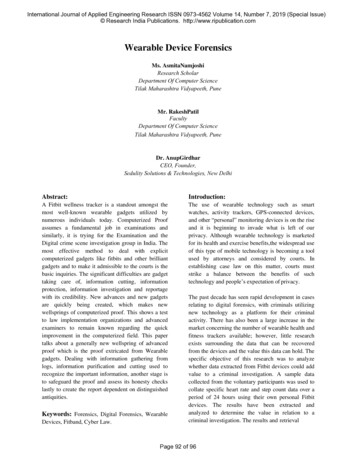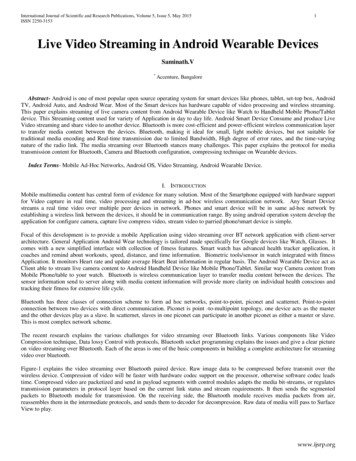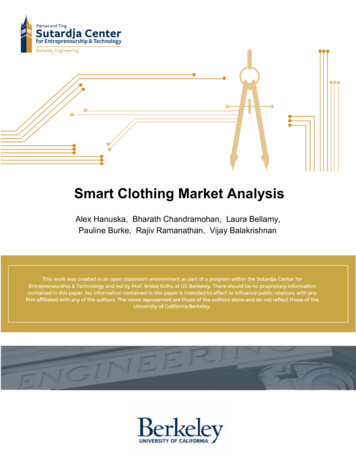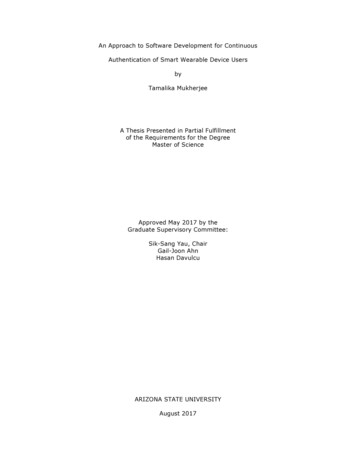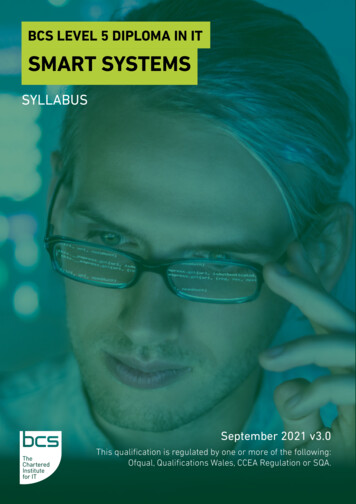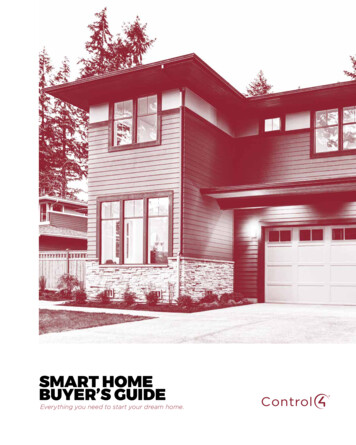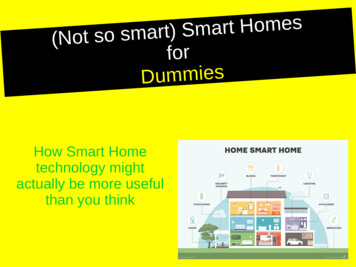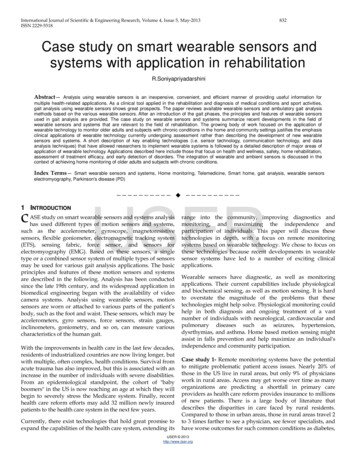
Transcription
International Journal of Scientific & Engineering Research, Volume 4, Issue 5, May-2013ISSN 2229-5518832Case study on smart wearable sensors andsystems with application in rehabilitationR.SoniyapriyadarshiniAbstract— Analysis using wearable sensors is an inexpensive, convenient, and efficient manner of providing useful information formultiple health-related applications. As a clinical tool applied in the rehabilitation and diagnosis of medical conditions and sport activities,gait analysis using wearable sensors shows great prospects. The paper reviews available wearable sensors and ambulatory gait analysismethods based on the various wearable sensors. After an introduction of the gait phases, the principles and features of wearable sensorsused in gait analysis are provided. The case study on wearable sensors and systems summarize recent developments in the field ofwearable sensors and systems that are relevant to the field of rehabilitation. The growing body of work focused on the application ofwearable technology to monitor older adults and subjects with chronic conditions in the home and community settings justifies the emphasisclinical applications of wearable technology currently undergoing assessment rather than describing the development of new wearablesensors and systems. A short description of key enabling technologies (i.e. sensor technology, communication technology, and dataanalysis techniques) that have allowed researchers to implement wearable systems is followed by a detailed description of major areas ofapplication of wearable technology. Applications described here include those that focus on health and wellness, safety, home rehabilitation,assessment of treatment efficacy, and early detection of disorders. The integration of wearable and ambient sensors is discussed in thecontext of achieving home monitoring of older adults and subjects with chronic conditions.Index Terms— Smart wearable sensors and systems, Home monitoring, Telemedicine, Smart home, gait analysis, wearable sensorselectromyography, Parkinson's disease (PD)IJSER—————————— ——————————c1 INTRODUCTIONASE study on smart wearable sensors and systems analysishas used different types of motion sensors and systems,such as the accelerometer, gyroscope, magnetoresistivesensors, flexible goniometer, electromagnetic tracking system(ETS), sensing fabric, force sensor, and sensors forelectromyography (EMG). Based on these sensors, a singletype or a combined sensor system of multiple types of sensorsmay be used for various gait analysis applications. The basicprinciples and features of these motion sensors and systemsare described in the following. Analysis has been conductedsince the late 19th century, and its widespread application inbiomedical engineering began with the availability of videocamera systems. Analysis using wearable sensors, motionsensors are worn or attached to various parts of the patient’sbody, such as the foot and waist. These sensors, which may beaccelerometers, gyro sensors, force sensors, strain gauges,inclinometers, goniometry, and so on, can measure variouscharacteristics of the human gait.With the improvements in health care in the last few decades,residents of industrialized countries are now living longer, butwith multiple, often complex, health conditions. Survival fromacute trauma has also improved, but this is associated with anincrease in the number of individuals with severe disabilities.From an epidemiological standpoint, the cohort of "babyboomers" in the US is now reaching an age at which they willbegin to severely stress the Medicare system. Finally, recenthealth care reform efforts may add 32 million newly insuredpatients to the health care system in the next few years.Currently, there exist technologies that hold great promise toexpand the capabilities of the health care system, extending itsrange into the community, improving diagnostics andmonitoring, and maximizing the independence andparticipation of individuals. This paper will discuss thesetechnologies in depth, with a focus on remote monitoringsystems based on wearable technology. We chose to focus onthese technologies because recent developments in wearablesensor systems have led to a number of exciting clinicalapplications.Wearable sensors have diagnostic, as well as monitoringapplications. Their current capabilities include physiologicaland biochemical sensing, as well as motion sensing. It is hardto overstate the magnitude of the problems that thesetechnologies might help solve. Physiological monitoring couldhelp in both diagnosis and ongoing treatment of a vastnumber of individuals with neurological, cardiovascular andpulmonary diseases such as seizures, hypertension,dysrthymias, and asthma. Home based motion sensing mightassist in falls prevention and help maximize an individual'sindependence and community participation.Case study 1- Remote monitoring systems have the potentialto mitigate problematic patient access issues. Nearly 20% ofthose in the US live in rural areas, but only 9% of physicianswork in rural areas. Access may get worse over time as manyorganizations are predicting a shortfall in primary careproviders as health care reform provides insurance to millionsof new patients. There is a large body of literature thatdescribes the disparities in care faced by rural residents.Compared to those in urban areas, those in rural areas travel 2to 3 times farther to see a physician, see fewer specialists, andhave worse outcomes for such common conditions as diabetes,IJSER 2013http://www.ijser.org
International Journal of Scientific & Engineering Research, Volume 4, Issue 5, May-2013ISSN 2229-5518and heart attack. Wearable sensors and remote monitoringsystems have the potential to extend the reach of specialists inurban areas to rural areas and decrease these disparities.A conceptual representation of a system for remotemonitoring is shown in Figure (Fig 1). Wearable sensors areused to gather physiological and movement data thusenabling patient's status monitoring. Sensors are deployedaccording to the clinical application of interest. Sensors tomonitor vital signs (e.g. heart rate and respiratory rate) wouldbe deployed, for instance, when monitoring patients withcongestive heart failure or patients with chronic obstructivepulmonary disease undergoing clinical intervention. Sensorsfor movement data capturing would be deployed, for instance,in applications such as monitoring the effectiveness of homebased rehabilitation interventions in stroke survivors or theuse of mobility assistive devices in older adults. Wirelesscommunication is relied upon to transmit patient's data to amobile phone or an access point and relay the information to aremote center via the Internet. Emergency situations (e.g. falls)are detected via data processing implemented throughout thesystem and an alarm message is sent to an emergency servicecenter to provide immediate assistance to patients. Familymembers and caregivers are alerted in case of an emergencybut could also be notified in other situations when the patientrequires assistance with, for instance, taking his/hermedications. Clinical personnel can remotely monitor patient'sstatus and be alerted in case a medical decision has to bemade.833system can be utilized on a large scale. These challengesinclude technological barriers such as limitations of currentlyavailable battery technology as well cultural barriers such asthe association of a stigma with the use of medical devices forhome-based clinical monitoring. In the following section, wediscuss key technologies enabling the development anddeployment of wearable technologies and remote monitoringsystems. The next section describes wearable and ambientsensor technologies that are essential components of systemsto monitor patients in the home and community settings.1.1 Enabling technologiesWearable systems for patients' remote monitoring consist ofthree main building blocks: 1) the sensing and data collectionhardware to collect physiological and movement data, 2) thecommunication hardware and software to relay data to aremote center, and 3) the data analysis techniques to extractclinically-relevant information from physiological andmovement data. Recent advances in sensor technology,microelectronics, telecommunication, and data analysistechniques have enabled the development and deployment ofwearable systems for patients' remote monitoring. Researchershave relied upon advances in the above-mentioned fields toaddress shortcomings of ambulatory technologies (e.g. Holtermonitors) that had previously prevented long-termmonitoring of patients' status in the home and communitysettings.IJSERFig-1, Illustration of a remote health monitoring system based on wearablesensors. Health related information is gathered via body-worn wirelesssensors and transmitted to the caregiver via an information gateway suchas a mobile phone. Caregivers can use this information to implementinterventions as needed.Despite the potential advantages of a remote monitoringsystem relying on wearable sensors like the one describedabove, there are significant challenges ahead before such aFig-2, Flexible wireless ECG sensor with a fully functional microcontroller.Developments in the field of flexible electronics are expected to lead to theadvent of smaller, lighter and more comfortable wearable systems.The miniaturization of sensors and electronic circuits based onthe use of microelectronics has played a key role in thedevelopment of wearable systems. One of the major hurdles tothe adoption of sensing technology, especially for wearableapplications, has been the size of the sensors and front-endIJSER 2013http://www.ijser.org
International Journal of Scientific & Engineering Research, Volume 4, Issue 5, May-2013ISSN 2229-5518electronics that, in the past, made the hardware to gatherphysiological and movement data too obtrusive to be suitablefor long-term monitoring applications. Recent developmentsin the field of microelectronics have allowed researchers todevelop miniature circuits entailing sensing capability, frontend amplification, microcontroller functions, and radiotransmission. The flexible circuit shown in Figure (Fig 2) is anexample of such technology and allows one to gatherphysiological data as well as transmit the data wirelessly to adata logger using a low-power radio. Particularly relevant toapplications in the field of rehabilitation are advances intechnology to manufacture micro electromechanical systems(MEMS). MEMS technology has enabled the development ofminiaturized inertial sensors that have been used in motoractivity and other health status monitoring systems. By usingbatch fabrication techniques, significant reduction in the sizeand cost of sensors has been achieved. Microelectronics hasalso been relied upon to integrate other components, such asmicroprocessors and radio communication circuits, into asingle integrated circuit thus resulting in System-on-Chipimplementations.Advances in material science have enabled the developmentof e-textile based systems. These are systems that integratesensing capability into garments. The example shown inFigure (Fig 3) demonstrates how sensors can be embedded ina garment to collect, for instance, electrocardiographic andelectromyographic data by weaving electrodes into the fabricand to gather movement data by printing conductiveelastomer-based components on the fabric and then sensingchanges in their resistance associated with stretching of thegarment due to subject's movements. Rapid advances in thisfield promise to deliver technology that will soon allow one toprint a full circuit board on fabric.834different electrode configurations as well as electromyographic (EMG)data. Additional sensors allow one to record thoracic and abdominalsignals associated with respiration and movement data related tostretching of the garment with shoulder movements.Health monitoring applications of wearable systems mostoften employ multiple sensors that are typically integratedinto a sensor network either limited to body-worn sensors orintegrating body-worn sensors and ambient sensors. In theearly days of body-worn sensor networks (often referred to as"body sensor networks"), the integration of wearable sensorswas achieved by running "wires" in pockets created ingarments for this purpose to connect body-worn sensors. Anexample of this technology is the MIThril system. Suchsystems by design were not suitable for long-term healthmonitoring. Recently developed wearable systems integrateindividual sensors into the sensor network by relying onmodern wireless communication technology. During the lastdecade, we have witnessed tremendous progress in this fieldand the development of numerous communication standardsfor low-power wireless communication. These standards havebeen developed keeping in mind three main requirements: 1)low cost, 2) small size of the transmitters and receivers, and 3)low power consumption.IJSERFig-3, Example of e-textile system for remote, continuous monitoringof physiological and movement data. Embedded sensors provide onewith the capability of recording electrocardiographic data (ECG) usingMost monitoring applications require that data gathered usingsensor networks be transmitted to a remote site such as ahospital server for clinical analysis. This can be achieved bytransmitting data from the sensor network to an informationgateway such as a mobile phone or personal computer. Bynow most developed countries have achieved almostuniversal broadband connectivity. For in-home monitoring,sensor data can be aggregated using a personal computer andtransmitted to the remote site over the Internet. Also, theavailability of mobile telecommunication standards such as 4G means that pervasive continuous health monitoring ispossible when the patient is outside the home environment.Case study 2- Mobile phone technology has had a majorimpact on the development of remote monitoring systemsbased on wearable sensors. Monitoring applications relying onmobile phones such as the one shown in Figure (Fig 4) arebecoming commonplace. Smart phones are broadly available.The global smart phone market is growing at an annual rate of35% with an estimated 400 million units shipped in 2013.Smart phones are preferable to traditional data loggersbecause they provide a virtually "ready to use" platform to logdata as well as to transmit data to a remote site. Besides beingused as information gateways, mobile devices can alsofunction as information processing units. The availability ofsignificant computing power in pocket-sized devices makes itpossible to envision ubiquitous health monitoring andintervention applications.In addition, most mobile devices now include an integratedGPS tracking system thus making it possible to locate patientsin case of an emergency. Also, as storage and computationbecomes more and more cloud based, health monitoringsystems can become low-cost, platform-independent, rapidlyIJSER 2013http://www.ijser.org
International Journal of Scientific & Engineering Research, Volume 4, Issue 5, May-2013ISSN 2229-5518deployable and universally accessible. Monitoring devices canbecome simpler and cheaper as the computation is pushed tothe cloud.835interventions to improve balance control and reduce falls, onewould be interested in using wearable sensors to track motionand vital signs. Specifically-designed data analysis procedureswould then be used to detect falls via processing of motionand vital sign data. In this context, ambient sensors could beused in conjunction with wearable sensors to improve theaccuracy of falls detection and, most importantly, to enable thedetection of falls even at times when subjects do not wear thesensors. This section provides a summary of the state of the artin wearable sensor technology and the development ofambient sensors.1.3 Wearable sensorsWearable systems for continuous health monitoring are a keytechnology in helping the transition to more practical andaffordable healthcare. It not only allows the user to closelymonitor changes in her or his physiological parameters butalso provides feedback to help maintain an optimal healthstatus. Physiological measures of interest in rehabilitationinclude heart rate, respiratory rate, blood pressure, bloodoxygen saturation, and muscle activity. Parameters extractedfrom such measures can provide indicators of health statusand have tremendous diagnostic value. Until recently,continuous monitoring of physiological parameters waspossible only in the hospital setting. But today, withdevelopments in the field of wearable technology, thepossibility of accurate, continuous, real-time monitoring ofphysiological signals is a reality.IJSERFig-4, Smart phone based ECG monitoring system by IMEC. The Androidbased mobile application allows low power ECG sensors to communicatewirelessly with the phone. With increasing computational and storagecapacity and ubiquitous connectivity, smart phones are expected to trulyenable continuous health monitoring.This enables users to buy off-the-shelf devices and accesscustomized monitoring applications via cloud-based services.Cloud-based systems can prove especially useful for bringinghealth care services to rural areas. In addition, monitoringapplications deployed via the cloud can be easily updatedwithout requiring that the patient installs any software onhis/her personal monitoring device, thus making systemmaintenance quick and cost effective.Finally, the massive amount of data that one can gather usingwearable systems for patient's status monitoring has to bemanaged and processed to derive clinically-relevantinformation. Data analysis techniques such as signalprocessing, pattern recognition, data mining and otherartificial intelligence-based methodologies have enabledremote monitoring applications that would have beenotherwise impossible.1.2 Sensing technologyIn this section, we provide information concerning the sensorsused in remote monitoring systems. Information gatheredusing body-worn (i.e. wearable) sensors is collectedubiquitously. Smart wearable sensors are often combined withambient sensors when subjects are monitored in the homeenvironment as schematically shown in Figure (Fig 5). Thecombination of wearable and ambient sensors is of greatinterest in several applications in the field of rehabilitation.For instance, when monitoring older adults while deployingCase study 3- Integrating physiological monitoring in awearable system often requires ingenious designs and novelsensor locations. For example, a ring sensor design formeasuring blood oxygen saturation (SpO2) and heart rate. Thering sensor was completely self-contained. Worn on the baseof the finger (like a ring), it integrated techniques for motionartifact reduction, which were designed to improvemeasurement accuracy. Applications of the ring sensor rangedfrom the diagnosis of hypertension to the management ofcongestive heart failure. A self-contained wearable cuff-lessphotoplethysmographic (PPG) based blood pressure monitorwas subsequently developed by the same research group. Thesensor integrated a novel height sensor based on two MEMSaccelerometers for measuring the hydrostatic pressure offsetof the PPG sensor relative to the heart. The mean arterialblood pressure was derived from the PPG sensor outputamplitude by taking into account the height of the sensorrelative to the heart.Another example of ingenious design is the system developedby Corbishley et al. to measure respiratory rate using aminiaturized wearable acoustic sensor (i.e. microphone). Themicrophone was placed on the neck to record acoustic signalsassociated with breathing, which were band-pass filtered toobtain the signal modulation envelope. By developingtechniques to filter out environmental noise and otherartifacts, the authors managed to achieve accuracy greaterIJSER 2013http://www.ijser.org
International Journal of Scientific & Engineering Research, Volume 4, Issue 5, May-2013ISSN 2229-5518than 90% in the measurement of breathing rate. The authorsalso presented an algorithm for the detection of apneas basedon the above-described sensing technology.In recent years, physiological monitoring has benefitedsignificantly from developments in the field of flexible circuitsand the integration of sensing technology into wearable items.An ear-worn, flexible, low-power PPG sensor for heart ratemonitoring was introduced by Patterson et al. The sensor issuited for long-term monitoring due to its location andunobtrusive design. Although systems of this type haveshown promising results, additional work appears to benecessary to achieve motion artifact reduction. Properattenuation of motion artifacts is essential to the deploymentof wearable sensors. Some of the problems due to motionartifacts could be minimized by integrating sensors into tightfitting garments. A comparative analysis of different wearablesystems for monitoring respiratory function was presented byLanata et al. The analysis showed that piezoelectricpneumography performs better than spirometry. Nonetheless,further advances in signal processing techniques to mitigatemotion artifacts are needed.836firefighters, which integrates a CO2 sensor with sensors tomeasure movement, environmental and body temperature,position, blood oxygen saturation, heart rate and respirationrate. The ProeTEX system can warn the firefighters of apotentially dangerous environment and also provideinformation about their well being to the control center. Thesystems developed in the above-mentioned projects could berelied upon to design robust e-textile based wearable systemsfor remote health monitoring applications.There has been a growing interest in the development of selfcontained lab-on-a-chip systems. Such systems canrevolutionize point-of-care medical testing and diagnosis bymaking testing and diagnosis fast, cheap and easily accessible.Wang et al. developed a system-on-chip (SOC), whichintegrates a pH and temperature sensor, for remotemonitoring applications. Their SOC includes generic sensorinterface, ADC, microcontroller, a data encoder and afrequency-shift keying RF transmitter. Similarly, Ahn et al.developed a low-cost disposable plastic lab-on-a-chip devicefor biochemical detection of parameters such as blood gasconcentration and glucose. The biochip contains an integratedbiosensor array for detecting multiple parameters and uses apassive microfluidic manipulation system instead of activemicrofluidic pumps.IJSERBiochemical sensors have recently gained a great deal ofinterest among researchers in the field of wearable technology.These types of sensors can be used to monitor the biochemistry as well as levels of chemical compounds in theatmosphere (e.g. to facilitate monitoring people working inhazardous environments). From a design point of view,biochemical sensors are perhaps the most complex as theyoften require collection, analysis and disposal of body fluids.Advances in the field of wearable biochemical sensors hasbeen slow, but research has recently picked up pace due to thedevelopment of micro and nano fabrication technologies. Forexample, Dudde et al. developed a minimally-invasivewearable closed-loop quasi-continuous drug infusion systemthat measures blood glucose levels and infuses insulinautomatically. The glucose monitor consists of a novel siliconsensor that continuously measures glucose levels using amicroperfusion technique and continuous infusion of insulinis achieved by a modified advanced insulin pump. The devicehas integrated Bluetooth communication capability fordisplaying and logging data and receiving commands from apersonal digital assistant (PDA) device.Case study 4- An array of bio-chemical sensors has beendeveloped as part of the BIOTEX project, supported by theEuropean Commission. Specifically, the BIOTEX project dealswith the integration of bio-chemical sensors into textiles formonitoring body fluids. Within this project, researchers havedeveloped a textile based fluid collecting system and sensorsfor in-vitro and in-vivo testing of pH, sodium andconductivity from body sweat. By in-vitro and in-vivo testingof the wearable system, researchers have shown that thesystem can be used for real-time analysis of sweat duringphysical activity. As part of a similar project called ProeTEX,Curone et al. developed a wearable sensorized garment forFinally, applications in rehabilitation of remote monitoringsystems relying on wearable sensors have largely relied uponinertial sensors for movement detection and tracking. Inertialsensors include accelerometers and gyroscopes. Often,magnetometers are used in conjunction with them to improvemotion tracking. Today, movement sensors are inexpensive,small and require very little power, making them highlyattractive for patient monitoring applications.1.4 Ambient sensorsExamples of instrumented environments include sensors andmotion detectors on doors that detect opening of, for instance,a medicine cabinet, refrigerator, or the home front door. Thisapproach has the characteristic of being totally unobtrusiveand of avoiding the problem of misplacing or damagingwearable devices. "Smart home" technology that includesambient and environmental sensors has been incorporated in avariety of rehabilitation related applications. One suchapplication is ambient assisted living (AAL) that refers tointelligent systems of health assistance in the individual'sliving environment. It covers concepts, products and servicesthat interlink and improve new technologies and the socialenvironment. AAL technologies are embedded (distributedthroughout the environment or directly integrated intoappliances or furniture), personalized (tailored to the users'needs), adaptive (responsive to the user and the user'senvironment) and anticipatory (anticipating users' desires asfar as possible without conscious mediation). Stefanov et alprovide a summary of the various types of devices that can beinstalled in smart homes, and the associated target userpopulations.IJSER 2013http://www.ijser.org
International Journal of Scientific & Engineering Research, Volume 4, Issue 5, May-2013ISSN 2229-5518Remote monitoring of patient status and self-management ofchronic conditions represent the most often pursuedapplications of AAL technologies. The combination ofwearable and ambient sensors is being explored andprototypes are being developed. A relevant application in thefield of rehabilitation relates to the identification of a patient'spatterns of activity and on providing suggestions concerningspecific behaviors and exercises for self-management of healthconditions. In this context, information gathered usingwearable sensors is augmented by information gathered usingambient sensors. Data collected using, for instance, body-wornaccelerometers could be augmented by motion sensorsdistributed throughout the home environment to determinethe type and intensity of the activities performed by itoring who suffers from, for instance, chronic obtrusivepulmonary disease could receive feedback about notoverexerting himself/herself and the performance ofrehabilitation exercises that would be prescribed in order tomaintain a satisfactory functional level.837system may issue a reminder to switch off devices and/orlights in an apartment or not to forget the pill box or themobile terminal needed to inform friends or neighbours whennecessary.Case study 5- Several smart home projects are currentlyongoing including the Technology Research for IndependentLiving (TRIL) Centre in Ireland, The TigerPlace in Missouri,the Oregon Centre for Aging and Technology (ORCATECH)in Oregon, the University of Rochester Centre for FutureHealth, The University of Florida Gator-Tech Smart House,the Georgia Institute of Technology Aware Home and theMassachusetts Institute of Technology PlaceLab. The main aimof such projects is to explore the use of ambient and/orwearable sensing technology to monitor the well-being ofindividuals in the home environment.2. APPLICATIONSThis section provides applications of smart wearable andambient sensors and systems that are relevant to the field ofrehabilitation. The material is organized in five sub-sectionsdevoted to summarizing applications focused on: 1) healthand wellness monitoring, 2) safety monitoring, 3) assessmentof treatment efficacy, and 4) early detection of disorders.IJSER2.1 Health & wellness monitoringAs the world population is aging and health care costs areincreasing, several countries are promoting "aging in place"programs which allow older adults and individuals withchronic conditions to remain in the home environment whilethey are remotely monitored for safety and for the purpose offacilitating the implementation of clinical interventions.Fig-5, Ambient sensors can unobtrusively monitor individuals in thehome environment. Ambient sensors can monitor activity patterns, sleepquality, bathroom visits etc. and provide alerts to caregivers whenabnormal patterns are observed. Such sensors are expected to make thehome of the future smarter and safer for patients living with chronicconditions.Innovative solutions for recognizing emergencies in the homecan be achieved through a combination of monitoring vitalparameters of the person living at home as well as supervisingthe conditions of domestic appliances. Personal safety can beimproved if vital data measures are combined with themonitoring and control of devices in the household. Remotemonitoring of potential sources of danger increases theindividual sense of security and can make life much easier andmore comfortable (e. g. checking whether the stove or thecoffee machine has been switched off and to be able to turnthem off remotely if necessary). Sensors embedded inelectrical devices and in doors and windows may beintegrated into an easy-to-use house-control
the association of a stigma with the use of medical devices for A conceptual representation of a system for remote monitoring is shown in Figure (Fig 1). Wearable sensors are used to gather physiological and movement data thus enabling patient's status monitoring. Sensors are deployed according to the clinical application of interest. Sensors to

